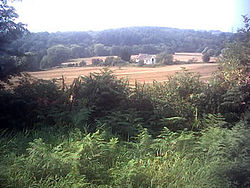Llanrothal: Difference between revisions
Created page with "{{Infobox town |county=Hereford |latitude=51.862599 |longitude=-2.763799 |LG district=Herefordshire |post town=Monmouth |postcode=NP25 |dialling code=01600 |constituency=Heref..." |
No edit summary |
||
| Line 11: | Line 11: | ||
|picture caption= View of the remote church of St John the Baptist | |picture caption= View of the remote church of St John the Baptist | ||
}} | }} | ||
'''Llanrothal''' is a small village and parish in the Monnow Valley of [[Herefordshire]], adjacent to the border with [[Monmouthshire]]. The [[River Monnow]] flows along the western boundary of the parish and also forms the county border.<ref name="EnglandJack1903">{{cite book|last=Jack|first=G. H.|title=Transactions of the Woolhope Naturalists' Field Club|url=https://books.google.com/books?id=QYcPAAAAYAAJ|accessdate=9 March 2012|year=1903|publisher=Woolhope Naturalists' Field Club, Hereford}}</ref> | '''Llanrothal''' is a small village and parish in the Monnow Valley of [[Herefordshire]], adjacent to the border with [[Monmouthshire]]. The [[River Monnow]] flows along the western boundary of the parish and also forms the county border.<ref name="EnglandJack1903">{{cite book|last=Jack|first=G. H.|title=Transactions of the Woolhope Naturalists' Field Club|url=https://books.google.com/books?id=QYcPAAAAYAAJ|accessdate=9 March 2012|year=1903|publisher=Woolhope Naturalists' Field Club, Hereford}}</ref> Since 1883, the civil parish has incorporated the detached part of Monmouthshire's [[Dixton|Dixton Newton]]. The village is located five miles by road north-west of [[Monmouth]] and contains a 12th-century church, St John the Baptist's which stands in a remote position close to the county border overlooking the river.<ref name=cct>{{Citation | url = http://www.visitchurches.org.uk/Ourchurches/Completelistofchurches/Church-of-St-John-the-Baptist-Llanrothal-Herefordshire/| title = Church of St John the Baptist, Llanrothal, Herefordshire| accessdate =29 March 2011| publisher=Churches Conservation Trust}}</ref> | ||
Llanrothal Court, in the village, is an early 14th-century hall house,<ref name="harvnb|Pevsner|p=240">{{harvnb|Pevsner|p=240}}</ref> with cross-wings added in the 15th or 16th century and further additions from the 17th, 19th and 20th centuries.<ref name="britishlistedbuildings1">{{cite web|author=Good Stuff IT Services |url=http://britishlistedbuildings.co.uk/en-153951-llanrothal-court-llanrothal |title=Llanrothal Court – Llanrothal – Herefordshire – England |publisher=British Listed Buildings |date=25 February 1966 |accessdate=10 March 2012}}</ref> It is a Grade-II listed building.<ref name="britishlistedbuildings1"/> | Llanrothal Court, in the village, is an early 14th-century hall house,<ref name="harvnb|Pevsner|p=240">{{harvnb|Pevsner|p=240}}</ref> with cross-wings added in the 15th or 16th century and further additions from the 17th, 19th and 20th centuries.<ref name="britishlistedbuildings1">{{cite web|author=Good Stuff IT Services |url=http://britishlistedbuildings.co.uk/en-153951-llanrothal-court-llanrothal |title=Llanrothal Court – Llanrothal – Herefordshire – England |publisher=British Listed Buildings |date=25 February 1966 |accessdate=10 March 2012}}</ref> It is a Grade-II listed building.<ref name="britishlistedbuildings1"/> | ||
Latest revision as of 18:50, 2 November 2019
| Llanrothal | |
| Herefordshire | |
|---|---|
 View of the remote church of St John the Baptist | |
| Location | |
| Location: | 51°51’45"N, 2°45’50"W |
| Data | |
| Post town: | Monmouth |
| Postcode: | NP25 |
| Dialling code: | 01600 |
| Local Government | |
| Council: | Herefordshire |
| Parliamentary constituency: |
Hereford and South Herefordshire |
Llanrothal is a small village and parish in the Monnow Valley of Herefordshire, adjacent to the border with Monmouthshire. The River Monnow flows along the western boundary of the parish and also forms the county border.[1] Since 1883, the civil parish has incorporated the detached part of Monmouthshire's Dixton Newton. The village is located five miles by road north-west of Monmouth and contains a 12th-century church, St John the Baptist's which stands in a remote position close to the county border overlooking the river.[2]
Llanrothal Court, in the village, is an early 14th-century hall house,[3] with cross-wings added in the 15th or 16th century and further additions from the 17th, 19th and 20th centuries.[4] It is a Grade-II listed building.[4]
Another historically important building in the village is The Cwm.[5] Originally a shooting box, and subsequently a farmhouse, it is also Grade-II listed, together with the terrace in front of the house, and the retaining wall to the side, which contains rare bee boles.[6] The present building, dating from about the 1830s, is on site of and incorporates part of a demolished 17th-century house that was a Jesuit province and college.[6]
History
Llanrothal was once a stronghold of the Jesuits and Papists such as Henry Milbourne, who resided in the village and whose family worshipped at The Cwm in the seventeenth century.[7] In the early 17th century the house became the headquarters of the Jesuit mission in South Wales and remained an important Catholic centre until its discovery and sacking by the Bishop of Hereford in 1678,[3] in the anti-Catholic backlash following the Popish Plot.[6] William Vychan, or William the Younger, also lived at Llanrothal,[8] although he is also associated with Penrhyn, in Caernarfonshire.[9]
Throughout its history, the village has been associated with nearby Welsh Newton,[10] and today the together form the Welsh Newton and Llanrothal Group Parish Council.
References
- ↑ Jack, G. H. (1903). Transactions of the Woolhope Naturalists' Field Club. Woolhope Naturalists' Field Club, Hereford. https://books.google.com/books?id=QYcPAAAAYAAJ. Retrieved 9 March 2012.
- ↑ Church of St John the Baptist, Llanrothal, Herefordshire, Churches Conservation Trust, http://www.visitchurches.org.uk/Ourchurches/Completelistofchurches/Church-of-St-John-the-Baptist-Llanrothal-Herefordshire/, retrieved 29 March 2011
- ↑ 3.0 3.1 Pevsner, p. 240
- ↑ 4.0 4.1 Good Stuff IT Services (25 February 1966). "Llanrothal Court – Llanrothal – Herefordshire – England". British Listed Buildings. http://britishlistedbuildings.co.uk/en-153951-llanrothal-court-llanrothal. Retrieved 10 March 2012.
- ↑ Morgannwg. Glamorgan History Society.. 1985. p. 16. https://books.google.com/books?id=RF1nAAAAMAAJ. Retrieved 9 March 2012.
- ↑ 6.0 6.1 6.2 Good Stuff IT Services (3 July 1985). "The Cwm, Front Terrace and Retaining Wall to South-west – Llanrothal – Herefordshire – England". British Listed Buildings. http://www.britishlistedbuildings.co.uk/en-153949-the-cwm-front-terrace-and-retaining-wall. Retrieved 10 March 2012.
- ↑ Catholic Record Society (Great Britain) (1982). Recusant history. Catholic Record Society.. p. 81. https://books.google.com/books?id=24cjAQAAIAAJ. Retrieved 9 March 2012.
- ↑ Burke, Sir Bernard (1863). A genealogical and heraldic dictionary of the landed gentry of Great Britain and Ireland. Harrison. p. 1571. https://books.google.com/books?id=Ni4BAAAAQAAJ&pg=PA1571. Retrieved 9 March 2012.
- ↑ Cambrian Archaeological Association (1849). Archaeologia cambrensis. W. Pickering. p. 102. https://books.google.com/books?id=nbQVAAAAYAAJ&pg=PA102. Retrieved 9 March 2012.
- ↑ Cape, Frank (1930). Two Historic Parishes: Welsh Newton and Llanrothal. Author. https://books.google.com/books?id=j7olPAAACAAJ. Retrieved 9 March 2012.
Sources
- Pevsner, Nikolaus (2003). Herefordshire. The Buildings of England. Yale University Press. ISBN 0 300 09609 7. https://books.google.co.uk/books?id=1SoNAQAAIAAJ&q=Pevsner+Herefordshire&dq=Pevsner+Herefordshire&hl=en&sa=X&ei=GyJbT83OJcer8APG7pSPDw&ved=0CDMQ6AEwAA.
Outside links
| ("Wikimedia Commons" has material about Llanrothal) |
